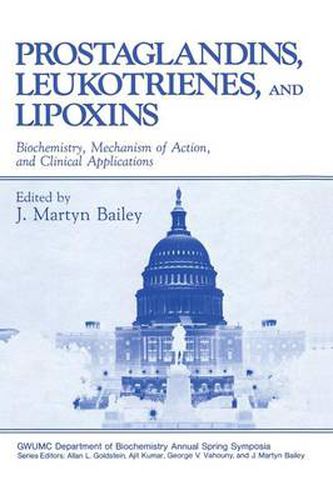Readings Newsletter
Become a Readings Member to make your shopping experience even easier.
Sign in or sign up for free!
You’re not far away from qualifying for FREE standard shipping within Australia
You’ve qualified for FREE standard shipping within Australia
The cart is loading…






This title is printed to order. This book may have been self-published. If so, we cannot guarantee the quality of the content. In the main most books will have gone through the editing process however some may not. We therefore suggest that you be aware of this before ordering this book. If in doubt check either the author or publisher’s details as we are unable to accept any returns unless they are faulty. Please contact us if you have any questions.
The family of known essential fatty acid metabolites continues to grow. Synthesis of the prostaglandins from essential fatty acids was first described by Bergstrom and Samuelsson in 1964. The thromboxanes were discovered in 1975, the pros- tacyclins, by Moncada and Vane, in 1976, and the leukotrienes by Samuelsson in 1979. The discovery of a new class of biologically active arachidonic acid metab- olites named lipoxins was announced by Bengt Samuelsson at the IVth International Spring Symposium on Health Sciences held in Washington D. C. , May 1984. This volume, Prostaglandins, Leukotrienes and Lipoxins, contains most of the papers presented in the plenary sessions of the Washington Symposium. The book is divided into six parts, each covering a different aspect of this rapidly expanding field, and contains a total of 63 chapters by an internationally recognized group of authors in each area. Part I contains 11 chapters and covers the basic biochemistry and enzymology of prostaglandins, leukotrienes, and lipoxins. Chapter 1 by Professor Samuelsson details the discovery of lipoxins. The enzymatic synthesis and biological activities of the first two members of this series, lipoxins A and B, are described. They appear to have selective secretagogue activity for human neutrophils. The lipoxins contain a conjugated trihydroxytetraene structure and thus differ significantly from the previously described leukotrienes and THETEs and, in contrast to these sub- stances, are derived by the integrated activity of two different lipoxygenase path- ways.
$9.00 standard shipping within Australia
FREE standard shipping within Australia for orders over $100.00
Express & International shipping calculated at checkout
This title is printed to order. This book may have been self-published. If so, we cannot guarantee the quality of the content. In the main most books will have gone through the editing process however some may not. We therefore suggest that you be aware of this before ordering this book. If in doubt check either the author or publisher’s details as we are unable to accept any returns unless they are faulty. Please contact us if you have any questions.
The family of known essential fatty acid metabolites continues to grow. Synthesis of the prostaglandins from essential fatty acids was first described by Bergstrom and Samuelsson in 1964. The thromboxanes were discovered in 1975, the pros- tacyclins, by Moncada and Vane, in 1976, and the leukotrienes by Samuelsson in 1979. The discovery of a new class of biologically active arachidonic acid metab- olites named lipoxins was announced by Bengt Samuelsson at the IVth International Spring Symposium on Health Sciences held in Washington D. C. , May 1984. This volume, Prostaglandins, Leukotrienes and Lipoxins, contains most of the papers presented in the plenary sessions of the Washington Symposium. The book is divided into six parts, each covering a different aspect of this rapidly expanding field, and contains a total of 63 chapters by an internationally recognized group of authors in each area. Part I contains 11 chapters and covers the basic biochemistry and enzymology of prostaglandins, leukotrienes, and lipoxins. Chapter 1 by Professor Samuelsson details the discovery of lipoxins. The enzymatic synthesis and biological activities of the first two members of this series, lipoxins A and B, are described. They appear to have selective secretagogue activity for human neutrophils. The lipoxins contain a conjugated trihydroxytetraene structure and thus differ significantly from the previously described leukotrienes and THETEs and, in contrast to these sub- stances, are derived by the integrated activity of two different lipoxygenase path- ways.